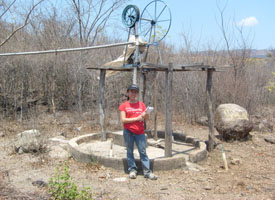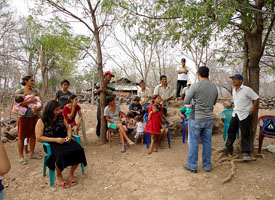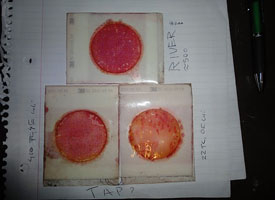When Christina Dang traveled to Nicaragua over spring break last week it wasn’t to relax carefree on a beach with her friends.
She chose to spend her time off from classes at the University of Houston in a different way.
Dang and four other members of the UH Chapter of Engineers Without Borders (EWB)—Ana Chavarria, Jorge Macias Jr., Katrina Zick and Rhys Forgie—worked on the beginnings of what will be a five-year partnership with three tiny villages tucked away on a rural mountainside in the Central American country.
About an hour drive from the capital—Managua—Telpochapa, La Uva and Bara Sonal residents will get help, through the UH partnership, to build their first elementary school as well as instruction on better agricultural and sanitation practices.
“We have been waiting a long time for this,” said Dang, the president of the UH chapter. “It feels so good to finally see a project out of country come full circle. I’m just sad I won’t be able to stay and see it through.”
Dang started the UH chapter of the organization, dedicated to improving the quality of life in communities across the world through sustainable engineering projects, three years ago. The opportunity for this alternative spring break fulfilled a longtime goal to secure a project outside the United States just two months before she is scheduled to graduate with her bachelor’s degree in chemical engineering.
Prior to the Nicaragua trip, the group had faced many setbacks related to their projects out of country—two separate plans for communities in Mexico alone fell through.
San Francisco Libre—the municipality encompassing the three villages—changed all that. Last summer, Forgie along with fellow EWB member and senior mechanical engineering major, Eric Bustamante, discovered one of their targeted villages, Telpochapa, on a trip to Nicaragua with mentors from the Rice University chapter of EWB. The visit opened their eyes to the possibility for a long-term project.
By January, the UH chapter had completed the necessary paperwork to get approval from their national organization to go on their first official assessment trip in March. With backing from BP America—who covered the cost of airfare—and several other local organizations, the team was on their way.
The trip, for the first time, allowed these students to apply their engineering knowledge and problem solving skills beyond outreach projects at local Houston schools offering youth a look at everything from a homemade water desalination station to instruction on how to build solar ovens from pizza boxes.
The five engineering students, and a professional engineer, Ruth Alkons Wolinksy, from a local chapter of EWB serving as their mentor, used the seven-day trip to familiarize themselves with the region and the residents in the three communities where they planned to partner.
Two nights and three full days were spent strengthening their relationship with residents and gathering information necessary to make them successful in the years to come.
“We slept in three houses in La Uva,” said Macias, a junior industrial engineering major. “I’d be asleep and feel chickens or dogs around me in the hammock."
The students ate food cooked by residents and with Macias and Chavarria’s help translating Spanish, they interviewed families in each of the 16 houses spanning the three communities about their needs.
Great detail was paid to capturing a picture of the communities to take back with them through digital photographs and GPS plots. Holes were dug and soil samples were taken. The water quality, from several locations in and around the villages, also was tested.
Yet, beyond the tests, immersion in their culture alone quickly revealed areas that needed attention, said Chavarria, a sophomore civil engineering major. This included improper disposal of trash and lack of ventilation in the homes for cooking. Both were contributing to some sickness experienced by residents.
Outside their stay in the communities, the students met with San Fransisco Libre officials about construction of the school.
“We had to make sure the community has buy in,” Dang said, noting the hope is they can help with some of the labor and learn skills along the way.
It was the first of many visits planned by the group.
“We went into this knowing that all EWB projects have to be a five-year commitment,” Dang said. “It doesn’t mean that we will take five years to build the school, but throughout those years we need to check up on projects and make sure they are working for the community. And then if we have other mini projects to add to that, we do it.”
This will include, she hopes, educating residents on how to better handle the trash as well as find a solution for their ventilation problems.
Over the course of the next month, the students will put together a complete plan for the school and education of the residents. Just as they did for the March trip, the group will present their ideas to the national organization. Upon approval by a panel of professional engineers, they will begin the next stage—implementation.
“We are hoping to return the end of August,” Macias said, noting travel sooner would be during their rainy season. “These communities are not even located on a map. Many of the roads we traveled in on were dried up rivers. They would be impossible to use any sooner.”
Amid detailing their plans for the communities, they will use the time to fundraise. The school alone is expected to cost upwards of $25,000.
Though tedious, the work is laying a solid foundation for future engineering students to carry out the mission of EWB through the chapter.
For Dang, they are weeks at UH and with the organization she established at the university, she is soaking in. But she warns that her May departure isn’t the last you will see of her.
“I would love to stay longer, but that’s just not possible” Dang admitted. “I have another plan. When I graduate I’m going to join the professional chapter of EWB and come back to help out the UH chapter.
| Help Fund Efforts |
|---|
| The UH Chapter of EWB is planning an auction later this year at the Ginger Man pub in Rice Village. The highest bidders will take home Nicaraguan made hammocks, hand painted plates showing the country’s landscape and bracelets. These funds, along with monetary donations made via the national chapter’s website will help with travel costs and materials for future work by the organization in the country. |



